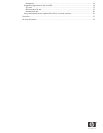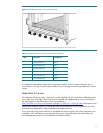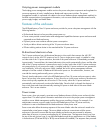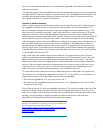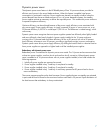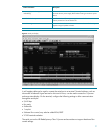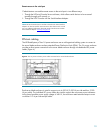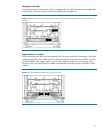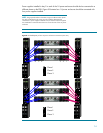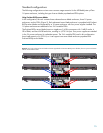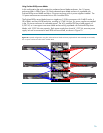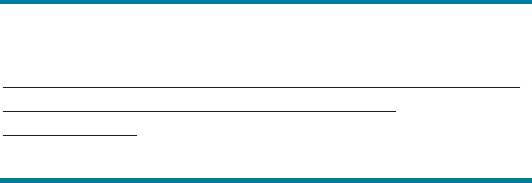
6
down to the next enclosure and continues until the bottom right blade in the bottom server blade
enclosure is powered.
In a rack that contains many server blade enclosures, the sequencing process may cause a significant
time delay before the last server blade is powered. However, this is preferable to the alternative—the
possibility that the main breakers trip due to the excessive load on the AC infrastructure as all the
server blade enclosures try to power simultaneously.
Firmware in mixed environments
When 1U power enclosures and 3U power enclosures are used in the same rack, the firmware must
be upgraded to the latest version for correct power zone operation. As of firmware release 2.20,
there are important changes in how power zones are managed. In firmware releases prior to 2.20,
there were only two power zones (zone 1 and 2) that were set by a switch on the rear of 3U power
enclosures. Firmware 2.20 provides the capability to have up to six power zones, based on the
absolute maximum hardware that could fit into one rack. The power zone switch on the rear of the 3U
power enclosure only has a setting for zone 1 and 2; new power zones start at 3 to avoid overlap
with existing power zones. The primary difference in setting the new power zones is that they are not
set by a switch on the power enclosure. The switch is still present on HP BladeSystem p-Class 3U
power enclosures for legacy firmware, but firmware version 2.20 and above do not use the switch.
The new power zones (3 and above) are set automatically by the firmware based on rack topology.
Unlike the 3U power enclosure, the 1U power enclosure does not have a power zone switch because
it was released with firmware 2.20.
Every power zone must include a power source (either the 1U power enclosure or the 3U power
enclosure) and at least one server blade enclosure. In the pre-2.20 firmware environment, if a server
blade enclosure were in zone 2 and the power enclosure supporting it were in zone 1, the server
blades and switches in that sever blade enclosure would never power on automatically because the
devices in the server blade enclosure must request power from a power source in their own zone in
order to power on. If the power source is not in the same zone as the server blade enclosure, the
request for power is not answered because power is not available in that zone.
To ensure that all power enclosures and server blade enclosures are configured in the proper zone,
all enclosures in a rack should be upgraded to firmware 2.20. If one enclosure in an infrastructure is
upgraded to firmware 2.20 and the other enclosures are not upgraded:
• The enclosure upgraded to 2.20 is put into power zone 3.
• The enclosures not upgraded are placed in power zone 1 or 2 (depending on the zone in which
the physical switch is set).
Once all the enclosures in a rack are upgraded to firmware 2.20, the switch setting on the rear of the
enclosure no longer serves a functional purpose. After an upgrade to firmware 2.20, power zone 1
and 2 are no longer used since the power zones are set automatically by the firmware based on rack
topology, not switch settings. HP does not support mixed firmware versions within the same
infrastructure. All enclosures should have the same firmware version.
NOTE: For more information on upgrading your firmware, see Chapter 5 of
the “HP ProLiant BL System Best Practices Guide”:
http://h20000.www2.hp.com/bc/docs/support/UCR/SupportM
anual/TPM_351359-001_rev1_us/TPM_351359-
001_rev1_us.pdf.




